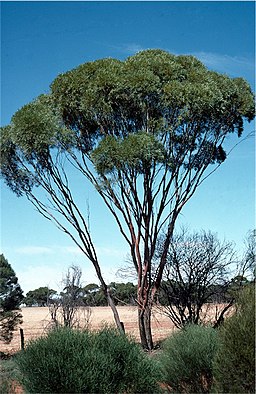Classification System: APG IV
Superregnum: Eukaryota
Regnum: Plantae
Cladus: Angiosperms
Cladus: Eudicots
Cladus: Core eudicots
Cladus: Rosids
Cladus: Eurosids II
Ordo: Myrtales
Familia: Myrtaceae
Subfamilia: Myrtoideae
Tribus: Eucalypteae
Genus: Eucalyptus
Species: Eucalyptus kochii
Subspecies: E. kochii subsp. kochii - E. kochii subsp. plenissima
Name
Eucalyptus kochii Maiden & Blakely
References
in Maiden, Crit. Rev. Eucalyptus viii. 41 (1929).
USDA, ARS, Germplasm Resources Information Network. Eucalyptus kochii in the Germplasm Resources Information Network (GRIN), U.S. Department of Agriculture Agricultural Research Service. Accessed: 09-Oct-10.
Eucalyptus kochii, commonly known as oil mallee,[2] is a species of mallee, sometimes a tree, and is endemic to Western Australia. It has rough, flaky or fibrous bark on the trunk, smooth grey bark above, linear to narrow lance-shaped adult leaves, flower buds in groups of nine to fifteen, white flowers and urn-shaped fruit.
Description
Eucalyptus kochii is a mallee that typically grows to a height of 8 m (26 ft), rarely a tree to 12 m (39 ft), and forms a lignotuber. It has rough, flaky or fibrous, light grey to brown bark on the trunk and larger branches, smooth grey to pink bark on the thinner branches. The adult leaves are arranged alternately, linear to narrow lance-shaped, the same shade of green on both sides, 55–115 mm (2.2–4.5 in) long and 5–13 mm (0.20–0.51 in) wide tapering to a petiole 5–12 mm (0.20–0.47 in) long. The flower buds are arranged in leaf axils, usually in groups of seven, nine or eleven on an unbranched peduncle 6–8 mm (0.24–0.31 in) long, the individual buds on pedicels 2–3 mm (0.079–0.118 in) long. Mature buds are cylindrical to spindle-shaped, the floral cup 4–5 mm (0.16–0.20 in) long and about 3–4 mm (0.12–0.16 in) wide with a conical to horn-shaped operculum of similar dimensions. Flowering occurs between October and February and the flowers are white. The fruit is a woody, oval to urn-shaped capsule 6–7 mm (0.24–0.28 in) long and 5–6 mm (0.20–0.24 in) wide with the valves protruding above rim level.[2][3][4]
Taxonomy
The species was formally described in 1929 by the botanists Joseph Maiden and William Blakely in Maiden's book, A Critical Revision of the Genus Eucalyptus.[5] The specific epithet (kochii) honours Max Koch for his "very keen interest in the flora of South and Western Australia".[6]
In 1950, Charles Gardner changed the name to E. oleosa var. kochii in the Journal of the Royal Society of Western Australia, but the change has not been accepted by the Australian Plant Census.[7][8] In the same journal, Gardner described E. oleosa var. borealis, the name of which has subsequently been changed to E. kochii subsp. borealis by Dean Nicolle,[9] and E. oleosa var. plenissima, changed to E. kochii subsp. plenissima by Ian Brooker.[10] In 2005, Dean Nicolle also described E. kochii subsp. amaryssia and subsp. yellowdinensis, publishing the names in the journal, Australian Systematic Botany.[11][12]
The five subspecies names recognised by the Australian Plant Census are:
Eucalyptus kochii subsp. amaryssia D.Nicolle[13] has fruit with a rounded operculum and very glossy adult leaves with a high oil content;[4]
Eucalyptus kochii subsp. borealis (C.A.Gardner) D.Nicolle[14] has fruit with a conical operculum and very glossy adult leaves;[4]
Eucalyptus kochii Maiden & Blakely subsp. kochii[15] has dull green adult leaves;[4]
Eucalyptus kochii subsp. plenissima (C.A.Gardner) Brooker[16] has fruit with a rounded operculum and very glossy adult leaves but with a very low oil content;[4]
Eucalyptus kochii subsp. yellowdinensis D.Nicolle[17] has unusually narrow, glossy green adult leaves but with a low oil content.[4]
Distribution
Oil mallee is found on flats, depressions, rises and along roadsides from Kondut to near Pindar in the Avon Wheatbelt and Yalgoo biogeographic regions of Western Australia where it grows in sandy-loamy-clay soils over laterite or granite.[2][3]
Cultivation
This eucalypt is cultivated in plantations for the production of eucalyptus oil. The distilled oil has a very high content of cineole (83-94%).[18][19]
References
"Eucalyptus kochii". Australian Plant Census. Retrieved 9 August 2019.
"Eucalyptus kochii Maiden & Blakely". FloraBase. Western Australian Government Department of Biodiversity, Conservation and Attractions.
Chippendale, George M. "Eucalyptus kochii". Flora of Australia. Australian Biological Resources Study, Department of the Environment and Energy, Canberra. Retrieved 9 August 2019.
"Eucalyptus kochii subsp. kochii". Euclid: Centre for Australian National Biodiversity Research. Retrieved 1 June 2020.
"Eucalyptus kochii". APNI. Retrieved 9 August 2019.
Maiden, Joseph (1929). A Critical Revision of the Genus Eucalyptus (Volume 8). Sydney: New South Wales Government Printer. p. 41. Retrieved 9 August 2019.
"Eucalyptus oleosa var. kochii". APNI. Retrieved 9 August 2019.
Gardner, Charles A. (1950). "The Western Australian Varieties of Eucalyptus oleosa F.Muell. ex Miq. and their essential oils". Journal of the Royal Society of Western Australia. 34: 78–79. Retrieved 9 August 2019.
"Eucalyptus kochii subsp. borealis". APNI. Retrieved 9 August 2019.
"Eucalyptus kochii subsp. plenissima". APNI. Retrieved 9 August 2019.
"Eucalyptus kochii subsp. amaryssia". APNI. Retrieved 9 August 2019.
"Eucalyptus kochii subsp. yellowdinensis". APNI. Retrieved 9 August 2019.
"Eucalyptus kochii subsp. amaryssia". Australian Plant Census. Retrieved 9 August 2019.
"Eucalyptus kochii subsp. borealis". Australian Plant Census. Retrieved 9 August 2019.
"Eucalyptus kochii subsp. kochii". Australian Plant Census. Retrieved 9 August 2019.
"Eucalyptus kochii subsp. plenissima". Australian Plant Census. Retrieved 9 August 2019.
"Eucalyptus kochii subsp. yellowdinensis". Australian Plant Census. Retrieved 9 August 2019.
Boland, D.J., Brophy, J.J., and A.P.N. House, Eucalyptus Leaf Oils, 1991, ISBN 0-909605-69-6
"100% Australian Eucalyptus Oil". Kochii Australian Eucalyptus Oil. Retrieved 21 October 2017.
Retrieved from "http://en.wikipedia.org/"
All text is available under the terms of the GNU Free Documentation License


